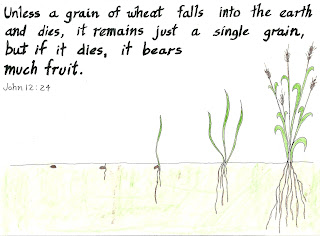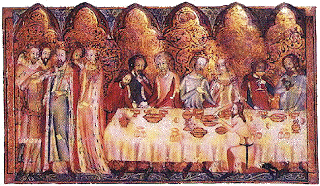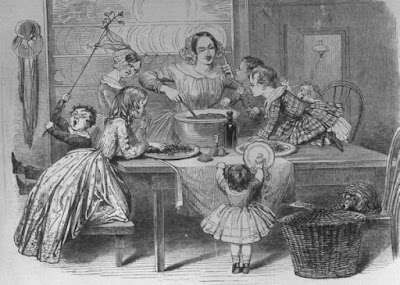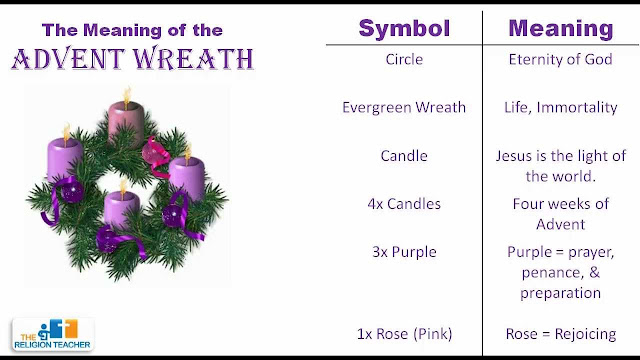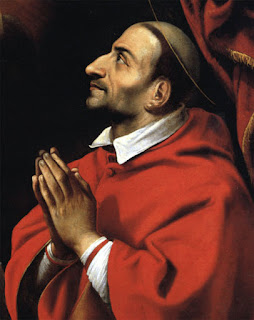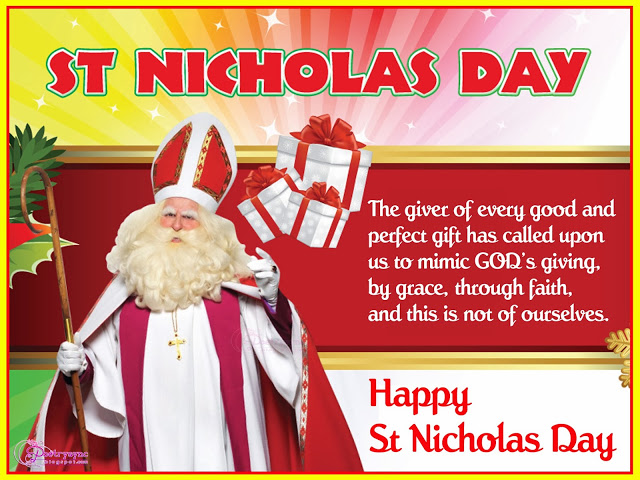 |
| St. Nicholas Day |
The legendary figure of St. Nicholas is derived from
Nicholas of Myra who officiated as a bishop in 4th century Greece. During his
lifetime he developed a reputation for gift-giving by putting coins in other
people's shoes, which accounts for many of today's Christmas traditions that
involve leaving gifts in shoes or boots.
 Having inspired both the figure of the North American Santa
Claus and the British Father Christmas, St. Nicholas has in some countries been
more recently joined on his visits to children's homes by an evil companion who
punishes the naughty ones: in Austria, Hungary, the Czech Republic and northern
Italy, this personification of evil is called Krampus, in Germany Knecht
Ruprecht, and in the Netherlands Zwarte Piet.
Having inspired both the figure of the North American Santa
Claus and the British Father Christmas, St. Nicholas has in some countries been
more recently joined on his visits to children's homes by an evil companion who
punishes the naughty ones: in Austria, Hungary, the Czech Republic and northern
Italy, this personification of evil is called Krampus, in Germany Knecht
Ruprecht, and in the Netherlands Zwarte Piet.
Why Celebrate St. Nicholas Day?
December 6 or December 19 on the Julian Calendar
St. Nicholas, a man of faith who lived his
life in devotion to Christ
• To focus on giving more than receiving: St. Nicholas cared
for the needy
• To emphasize small treats and family fun: St. Nicholas
loved children
• To provide a bit of special festivity early in the waiting
weeks of Advent: St. Nicholas points to Jesus, the heart of Christmas
• To offer a spiritual dimension to gift giving
• To tell the story of a Christian saint, whose model life
inspires compassion and charity
• To honor St. Nicholas honors the Christ Child who
selflessly gave the greatest gift of all—himself
St. Nicholas' feast day, December 6, is one of the
highlights of the Advent season. It is on this eve that our children hang their
stockings. From babyhood they learn to love the kind bishop with his mitre,
staff and bag of gifts--whose name has become parodied as "Santa
Claus" and whose memory is tarnished by commercialism.
In addition to the toys received on this feast, the
Christ-Child and His angels bring other gifts on Christmas Eve; and the Magi a
few more on Epiphany.
Placing less exclusive emphasis on December 25 as the day of
presents and also curtailing its gifts somewhat makes it easier to place more
emphasis on the religious aspects of that great holy day.
Do other children
think ours are queer? Not at all. If anything, they are a bit envious of
children who receive Yule gifts so early and who enjoy such a happy feast as
our traditional St. Nicholas Day party. Having an early gift day also makes it
possible for the children to give some of these gifts as Christmas presents to
other less fortunate children.
Treats of the St. Nicholas party are the exchange of gifts, genuine
Dutch cookies and Bishopwyn (bishop's wine). For children the wine is grape
juice. But the grownups who face the high December winds along the Hudson River
to pick up their children at our house always welcome the mulled Bishopwyn. Its
recipe is from our favorite cook book, "Cooking for Christ" by
Florence Berger.
1 bottle of Claret 6 cloves 4 inches stick
cinnamon
Break cinnamon into small pieces. Simmer wine and spices for
about five minutes. Strain wine. Serve hot.
 |
| The Speculatius, a spice cookie from the Netherlands |
The Speculatius, a spice cookie from the Netherlands, like
all of Mrs. Berger's recipes, is foolproof.
1 cup butter 4 tsp. cinnamon
1 cup lard 1/2 tsp. nutmeg
2 cups brown sugar 1/2 tsp. cloves
1/2 cup sour cream 4-1/2 cups sifted flour
1/2 tsp. soda 1/2 cup chopped nuts
Cream the butter, lard and sugar. Add sour cream alternately
with sifted dry ingredients. Stir in the nuts. Knead the dough into rolls. Wrap
the rolls in wax paper and chill them in the refrigerator overnight. Roll the
dough very thin and cut into shapes. Bake in moderate oven (375 degrees) for 10
to 15 minutes.
The dough may be cut into St. Nicholas shapes, or into the
shape of birds, fish or animals. We also like to cut out stocking shapes and
ice them in honor of St. Nicholas, patron of school boys.
During the party we light the Advent wreath candle, and the children
sing Advent hymns. All classes at Corpus Christi School have wreaths, but some
of the children do not have them at home. We have found that parents, enjoying
their Bishopwyn, have become interested in the wreath and have integrated the
Advent program of school and home as a result of the St. Nicholas Day party.
Excerpt taken from FAMILY ADVENT CUSTOMS by Helen McLoughlin


